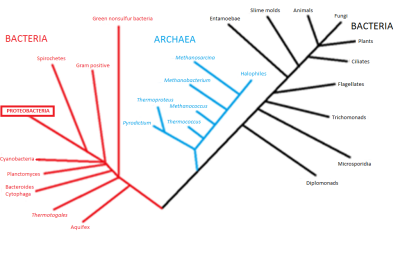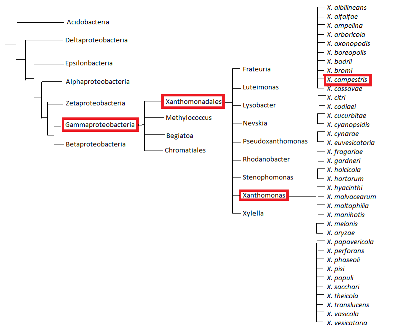Oh you know my daddy..lets see about that.

CLASSIFICATION
Taxonomic classification of Xanthomonis campestris

DOMAIN: Bacteria
KINGDOM: Bacteria
PHYLUM: Proteobacteria
CLASS: Gamma
Proteobacteria
ORDER: Xanthomonadales
FAMILY: Xanthomonadacae
GENUS: Xanthomonas
SPECIES: Xanthomonas campestris
___________________________________________________________________________________________________
Classification standards for Xanthomonas campestris:
Bacteria (Domain):
Organisms
within this group are identified as prokaryotes, lacking a nucleus
and membrane-bound organelles. Organisms' cell walls contain peptidoglycan.
(Brevibacterium
linen
is another organism that is
categorized in the bacteria domain.)
Bacteria (Kingdom): Additional to the
previous taxonomic information given in the bacteria domain section,
all organisms found in the bacteria kingdom are unicellular and
consist of mainly "free-living" bacteria.
(Deinococcus
radiodurans, known as the world's toughest
bacteria is even in this kingdom.)
Proteobacteria: When organisms
are classified in this class they are to have a gram-negative
bacteria. It is common for proteobacteria to pathogenic as
well.
(Neisseria
Meningitidis, the
bacteria to cause for bacterial meningitis can be found here as
well.)
Gamma proteobacteria:
Within this large subgroup lies the Gram-negative bacteria
that are capable of undergoing fermentation and live under aerobic
conditions.
(Legionella pneumophila, is another pathogenic bacterium in
this group that is known as the cause of
Legionnaire's Disease.)
Xanthomonadales:
Within this order there are no formation of endospores.
Organisms are classified as obligate aerobes. They are more
specifically identified as Gram-negative straight rods.
Xanthomonadacae: Environmental
organisms found in moist soil areas. Plant pathogenic
bacterial species, and one known human pathogen is located here.
Xanthomonas: Organisms
within this genus typically are catalase positive; oxidase negative.
Colonies are typically yellow pigmented. Some are motile by a
single polar flagellum. Gram-negative single rods, mostly
single or in pairs. Do not have resting stages within life
cycle.
Xanthomonas campestris:
A Gram-negative rod shaped plant pathogenic bacteria. Targets
specifically plants within the crucifer family. Its associated
disease is commonly known as the black rot, which is an systemic
disease which eventually leads to necrosis. The protective
coating of the bacterium is also used to produce the food additive
xanthan gum.

The true meaning behind Xanthomonas campestris
needs to be determined by putting together all the individual
meanings of the roots of the name:
- adj. Xanthus
= yellow
- n. monas = unit,
monad
- n. Xanthomonas =
yellow monad
- v. campestris =
"growing in or associated to fields"
The more meaningful name to remember Xanthomonas campestris (Xcc)
for is either is plant pathogen name, black rot or by the food
additive product, xanthan gum. These both have a logical
reasoning behind their meaning. The
black rot refers to Xcc's parasitic relationship with
crucifer plants. Also xanthan gum
naming scheme comes from the fermentation process of the outer
coating of Xcc that produces this food additive.
_____________________________________________________________________________________

The above phylogenetic tree, located next to Xanthomonas
campestris' complete taxonomic classification, goes into detail
of the morphological levels that associate with Xcc.
However, that phylogenetic tree only represents to the specific
phylum that Xcc is associated with, so a more detailed
morphological phylogenetic tree is represented below of
Xcc:

_________________________________________________________________________________________________
As seen, Xanthomonas campestris
has many close relatives that also participate in this destructive
parasitic lifestyle. Even though other organisms participate
in this type of lifestyle, it is important to understand what
Xcc has as a specific location and
habitat that will benefit the pathogenic bacteria's life cycle.
-- HOME -- REFERENCES -- CONTACT ME -- MULTIPLE ORGANISMS --